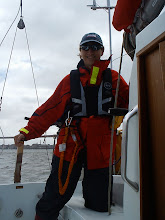Friday 04/07/08
We planned ahead knowing that we would be either on a visitor's mooring or at anchor when we arrived at St Ives bay, so we stocked up with diesel, meths, water and pasties. I was very impressed by the practicality of pasties for sailing, there are easy to warm ( 12v microwave ), easy to eat, and the seagulls eat the leftovers. They also have an excellent veggie and vegan range here in Padstow, together with fruit pasties. Yummy.
We left to catch the start of the SW tide, again the River Camel looked very inviting on the way out, but this time at high tide.

I noticed that as we were heading out to sea, the engine speed to RPM seemed too slow, so I managed to get the boathook underwater to the propeller and snagged some orange fishing line, apparently around the prop again. Rather that get all the diving kit on, I decided to just go for swimming costume and snorkel. It was very cold. Once I got my breath back after entering the water, I dived under the boat and had to cut away the orange twine and seaweed. The engine was back to running, but I was cold for hours after.
Rather than take the direct course from Padstow to St Ives, we followed the coastline. Nick is a keen photographer being too far out to sea for decent photos is frustrating.
We arrived in St Ives bay, and looked for likely visitors moorings that stay afloat - we needed to leave at low tide on Friday. I really could not identify any moorings, they all could have easily been pot buoys. No answer again from the HM number from the almanac. So we dropped anchor in 5m ( 10kg Delta ), it took beautifully and St Ives gave us a nice selection of transits to make sure that we were not drifting.
The only other vessel in St Ives bay was a wooden square-rigger anchored. About an hour after we arrived, she raised anchor and fired a couple of small cannon whilst she circled us. This was all very surreal and entertaining.

A wonderful quiet night at anchor in St Ives Bay, only slightly clouded by the 05:00 start the next morning.













































